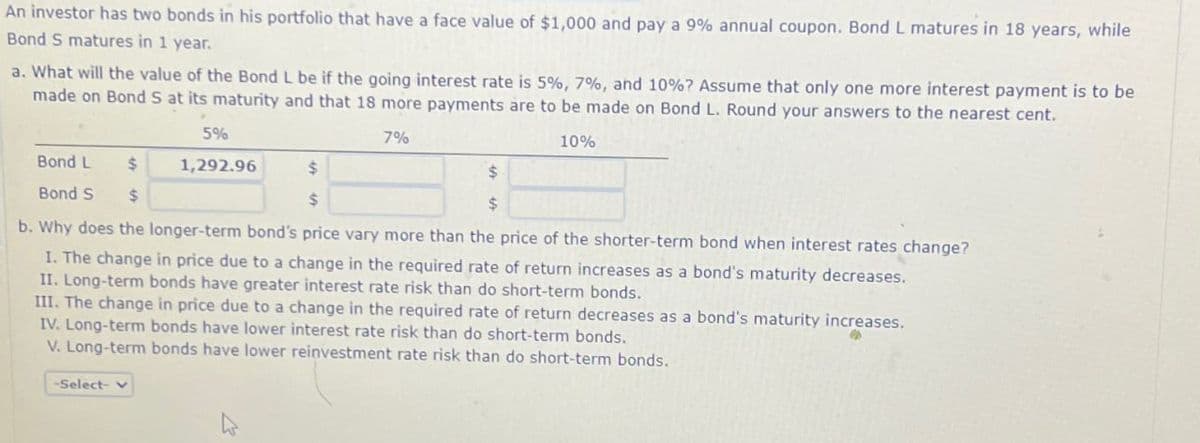An investor has two bonds in his portfolio that have a face value of $1,000 and pay a 9% annual coupon. Bond L matures in 18 years, while Bond S matures in 1 year. a. What will the value of the Bond L be if the going interest rate is 5%, 7%, and 10%? Assume that only one more interest payment is to be made on Bond S at its maturity and that 18 more payments are to be made on Bond L. Round your answers to the nearest cent. 5% 7% 10% Bond L $ Bond S $ 1,292.96 $ $ $ $ b. Why does the longer-term bond's price vary more than the price of the shorter-term bond when interest rates change? I. The change in price due to a change in the required rate of return increases as a bond's maturity decreases. II. Long-term bonds have greater interest rate risk than do short-term bonds. III. The change in price due to a change in the required rate of return decreases as a bond's maturity increases. IV. Long-term bonds have lower interest rate risk than do short-term bonds. V. Long-term bonds have lower reinvestment rate risk than do short-term bonds. -Select- v
An investor has two bonds in his portfolio that have a face value of $1,000 and pay a 9% annual coupon. Bond L matures in 18 years, while Bond S matures in 1 year. a. What will the value of the Bond L be if the going interest rate is 5%, 7%, and 10%? Assume that only one more interest payment is to be made on Bond S at its maturity and that 18 more payments are to be made on Bond L. Round your answers to the nearest cent. 5% 7% 10% Bond L $ Bond S $ 1,292.96 $ $ $ $ b. Why does the longer-term bond's price vary more than the price of the shorter-term bond when interest rates change? I. The change in price due to a change in the required rate of return increases as a bond's maturity decreases. II. Long-term bonds have greater interest rate risk than do short-term bonds. III. The change in price due to a change in the required rate of return decreases as a bond's maturity increases. IV. Long-term bonds have lower interest rate risk than do short-term bonds. V. Long-term bonds have lower reinvestment rate risk than do short-term bonds. -Select- v
Chapter5: The Time Value Of Money
Section: Chapter Questions
Problem 11P
Related questions
Question
None

Transcribed Image Text:An investor has two bonds in his portfolio that have a face value of $1,000 and pay a 9% annual coupon. Bond L matures in 18 years, while
Bond S matures in 1 year.
a. What will the value of the Bond L be if the going interest rate is 5%, 7%, and 10%? Assume that only one more interest payment is to be
made on Bond S at its maturity and that 18 more payments are to be made on Bond L. Round your answers to the nearest cent.
5%
7%
10%
Bond L $
Bond S $
1,292.96
$
$
$
$
b. Why does the longer-term bond's price vary more than the price of the shorter-term bond when interest rates change?
I. The change in price due to a change in the required rate of return increases as a bond's maturity decreases.
II. Long-term bonds have greater interest rate risk than do short-term bonds.
III. The change in price due to a change in the required rate of return decreases as a bond's maturity increases.
IV. Long-term bonds have lower interest rate risk than do short-term bonds.
V. Long-term bonds have lower reinvestment rate risk than do short-term bonds.
-Select- v
Expert Solution
This question has been solved!
Explore an expertly crafted, step-by-step solution for a thorough understanding of key concepts.
This is a popular solution!
Trending now
This is a popular solution!
Step by step
Solved in 2 steps

Recommended textbooks for you

EBK CONTEMPORARY FINANCIAL MANAGEMENT
Finance
ISBN:
9781337514835
Author:
MOYER
Publisher:
CENGAGE LEARNING - CONSIGNMENT

Intermediate Financial Management (MindTap Course…
Finance
ISBN:
9781337395083
Author:
Eugene F. Brigham, Phillip R. Daves
Publisher:
Cengage Learning

EBK CONTEMPORARY FINANCIAL MANAGEMENT
Finance
ISBN:
9781337514835
Author:
MOYER
Publisher:
CENGAGE LEARNING - CONSIGNMENT

Intermediate Financial Management (MindTap Course…
Finance
ISBN:
9781337395083
Author:
Eugene F. Brigham, Phillip R. Daves
Publisher:
Cengage Learning